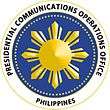Presidential Communications Group (Philippines)
| Agency overview | |
|---|---|
| Headquarters | 3rd Floor, New Executive Building, Malacañan Palace, Manila |
| Annual budget | ₱1.3 billion (2013)[1] |
| Agency executives |
|
| Website |
www www |
The Presidential Communications Group or simply the Communications Group, is a collective name for the newly formed offices within the Office of the President of the Philippines and refers to the following positions and offices: the Presidential Spokesman and the Presidential Communications Office (PCO, formerly the Office of the Press Secretary).
The Communications Group is primarily responsible for planning, programming, and coordinating the activities that will most effectively collect information about what is happening in the Executive branch of the government, and getting this information to the media. The Group's other role is to help Filipinos understand government policies and programs, and to shore up support for them.
Presidential Spokesman
.png)
The Presidential Spokesman speaks in behalf of the President on matters of public interest, among other things. Considering the restricted level of access that the media has to the Chief Executive, the Spokesman is expected to be the primary source of presidential directives in the absence of the President of the Philippines.
The Presidential Spokesman is not subject to confirmation by the Commission on Appointments, and does not have any specific item or plantilla in government.[2]
Presidential Communications Office

The Presidential Communications Office (PCO) is in charge of disseminating the government’s message to private media entities. It exercises supervision and control over state-owned media entities, to ensure the proper and effective dissemination of the official messages in accordance with the Communications Plan. It is responsible for the accreditation and authentication of the credentials of foreign media correspondents, in line with its primary task to cultivate relations and provide the necessary assistance to private media entities.[3] During the administration of Benigno Aquino III, the PCO was named as the "Presidential Communications Operations Office" (PCOO).
The PCO is headed by the PCO Head with Cabinet rank. He is assisted by an Undersecretary for Administration and Finance, an Undersecretary for Operations, a Chief of Staff, an Assistant Secretary for Legislative Affairs, and an Electronic Data Processing Division Chief.[4]
The PCO is composed of the following units and agencies:
- News and Information Bureau
- Philippines News Agency
- Philippine Information Agency
- Intercontinental Broadcasting Corporation
- People's Television Network
- Philippine Broadcasting Service - Bureau of Broadcast Services (Radyo ng Bayan)
- PBS-Radio-Television Malacañang
- Bureau of Communications Services
- National Printing Office
- APO Production Unit
- OP Web Development Office (commonly referred to as the President's New Media Team)
- Presidential Communications Development and Strategic Planning Office (PCDSPO)
Units under the Presidential Communications Office
Presidential News Desk
The Presidential News Desk (PND) functions as the newsroom of Malacañang. It gathers and disseminates information, such as press and photograph releases, and official statements from the Palace, on a daily basis.
The PND operates from Sundays to Saturdays, 5:00 AM to 7:00 PM. It is headed by a chief editor and is composed of a managing editor, deskmen, and reporters. Other units, which support the PND are Electronic Data Processing, Transcription and Monitoring, and Photographs.
The PND was conceived by Francisco Tatad, who was the Press Secretary to President Ferdinand Marcos. It was called the Central Desk and was located in the Mabini Building. During the administration of President Corazon C. Aquino, Press Secretary Benigno Teodoro relegated the Central Desk, which became the News and Reportorial Section, as a section of the Presidential Press Staff. Under the Ramos administration, Press Secretary Rodolfo Reyes strengthened presidential coverage and set up the PND.
Philippine Information Agency

The Philippine Information Agency (PIA), established through Executive Order No. 100, is the main development communication arm of the government. It is under the Presidential Communications Operations Office (PCOO).
The Philippine Information Agency (PIA) directly serves the Presidency and the Executive Branch on the national, regional and provincial levels through its sixteen (16) regional offices and seventy-one (71) provincial information centers.
PIA’s core services include information gathering/research, production and dissemination, and institutional development and capacity-building focusing on alliance-building, networking, communication-related training, consultancy and technical assistance.
It is currently headed by Harold E. Clavite (Director-General) and Gregorio Angelo C. Villar (Deputy Director-General) assisted by Staff Directors in the Central Office, Regional Directors in the Regional Offices, and more than 300 employees.
Its slogan is "Empowering Communities".
Bureau of Communication Services
The Bureau of Communication Services is the attached agency of the PCOO that is tasked to provide materials and services related to various functions of the Presidency, PCOO and the general public.
It also produces information materials for state events such as the anniversary of the People Power Revolution, Araw ng Kalayaan celebrations, and others. Director IV John S. Manalili is the Bureau's current director.
Presidential Broadcast Staff - Radio TV Malacañang
Created[5] by President Corazon C. Aquino, the Presidential Broadcast Staff - Radio Television Malacañang is tasked to provide the necessary media services, video and audio, to the incumbent President, to document all official engagements and to make available to the public accurate and relevant information on the activities, programs and pronouncements of the national leadership.
The agency is involved in television coverage and documentation, news and public affairs syndication of all the activities of the President, either live or delayed telecast through government or private collaborating networks.
Television and radio networks (Media ng Bayan)
There are two government-run television networks, which are the People's Television Network (PTV-4), the Intercontinental Broadcasting Corporation (IBC-13), and the Philippine Broadcasting Service (PBS) constitute the government radio network.
IBC-13 and RPN-9 were sequestered by the government after the fall of the Marcos dictatorship. However, plans are being made to privatize IBC-13 and RPN-9 within two years to raise money. According to the 2009 report of the Presidential Commission on Good Government (PCGG), IBC-13 is valued at PHP 3.074 billion while RPN-9 is valued at PHP 1.3 billion.[6][7]
National Printing Office
The National Printing Office (NPO) was established by Executive Order.[8] Executive Order 285 abolished the General Services Administration and transferred its functions to other agencies. Its Government Printing Offices were merged with the printing units of the PIA. The NPO is mandated by Executive Order 285 to print forms, official ballots, public documents, and public information materials.
News and Information Bureau
The News and Information Bureau's main aim is to provide services relating to the development and formulation of a domestic and foreign information program for the Government in general, and the Presidency in particular, including the development of strategies for the dissemination of information on specific government programs. It is composed of the following divisions:
- Finance and Administrative Division
- Presidential Press Staff
- Media Accreditation and Relations Division/International Press Center
- Philippines News Agency
OP Web Development Office
The OP Web Development Office or commonly referred to as the President's New Media Team is responsible for the establishment and management of the President's Official Website and Official Presence on Social Networking Channels such as Facebook, Twitter, and YouTube. It is also partly responsible for the feedback mechanism of the President wherein it receives the comments, concerns and suggestions through the Contact Us section of the President's website. It is also responsible for the President's Social Media engagement and in maximizing the use of new technologies to further the President's agenda, policies and programs.
Presidential Communications Development and Strategic Planning Office

The Presidential Communications Development and Strategic Planning Office (PCDSPO) ensures that all aspects of communications are covered, to ensure that the administration’s message has been delivered successfully. This includes market research and polling. It devises the communications strategy to promote the President’s agenda throughout all media, and among the many publics with which the administration interacts. This can include, but is not limited to, the State of the Nation address, televised press conferences, statements to the press, and radio addresses. This office also works closely with cabinet-level departments and other executive agencies, in order to create a coherent strategy through which the president’s message can be disseminated.[9]
During the administration of former president Benigno Aquino III, the PCDSPO is headed by the PCDSPO Head, with Cabinet rank. He is supported by a Deputy of Undersecretary rank, a Chief of Staff, an Assistant Secretary for Messaging, and an Electronic Data Processing Division Chief.[10] After Rodrigo Duterte became the president, the PCDSPO was merged with the PCOO and the latter became the remaining organization, and was renamed as the "Presidential Communications Office.[11]
The PCDSPO was composed of the following units and agencies, as of June 30, 2016, all of the units and agencies are under the PCO:
- Presidential Message Staff
- The OP Correspondence Office (previously placed under the Office of the Communications Director from the Presidential Management Staff per E.O. No. 348, 11 August 2004)
- Media Research and Development Staff[12]
- The Presidential Museum and Library
- The Official Gazette
- The Speech Writers Group (previously placed under the Office of the Communications Director from the Presidential Management Staff[13])
Other officials
- As of 2016 – present under the Duterte admninistration:
Undersecretaries
- Noel Puyat (Administration and Finance)
- George Apacible (Good Governance and Government-owned & Controlled Corporations)
- Enrique Tandan III (Operations and Legal Affairs)
Assistant secretaries
- Kissinger Reyes (Chief Information Officer/OIC-Director for Administration and Finance)
- Michel Kristian Ablan (Policy and Legislative Affairs; Chief of Staff to the Secretary of PCO)
- Ana Maria Paz "Marie" R. Banaag (Legal Affairs; Operations and Special Concerns)
- Ramon Cualoping III (Strategic Communications)
- Joseph Lawrence Garcia (Mindanao Affairs)
- Rachel Queenie Rodulfo (Content and Messaging; Media Relations)
References
- ↑ "Summary of Allocations | Budget ng Bayan". Budget ng Bayan. Retrieved 29 April 2013.
- ↑ http://www.philstar.com/Article.aspx?articleid=592204
- ↑ http://www.gov.ph/2010/08/09/briefing-on-presidential-communications-reforms/
- ↑ http://www.gov.ph/2010/07/30/executive-order-no-4/
- ↑ under Executive Order No. 297 on July 25, 1987
- ↑ Marcos bucks plan to sell 2 TV networks Inquirer.net 2010-08-10. Retrieved 2010-08-10.
- ↑ PCGG urges gov’t to fast-track sale of RPN-9, IBC-13 ABS-CBNnews.com. 2010-08-10. Retrieved 2010-08-10.
- ↑ No. 285 on July 25, 1987
- ↑ http://www.gov.ph/2010/08/09/briefing-on-presidential-communications-reforms/
- ↑ http://www.gov.ph/2010/07/30/executive-order-no-4/
- ↑ Martin Andanar eyes renaming PCOO, Patricia Lourdes Viray, The Philippine Star, June 16, 2016
- ↑ created by E.O. No. 297, 25 July 1987, from the Office of the Press Secretary
- ↑ per E.O. No. 348, 11 August 2004
External links
- The Philippine President's Cabinet
- About the PCOO
- Executive Order No. 4 Creating the Communications Group
- Briefer on Executive Order No. 4